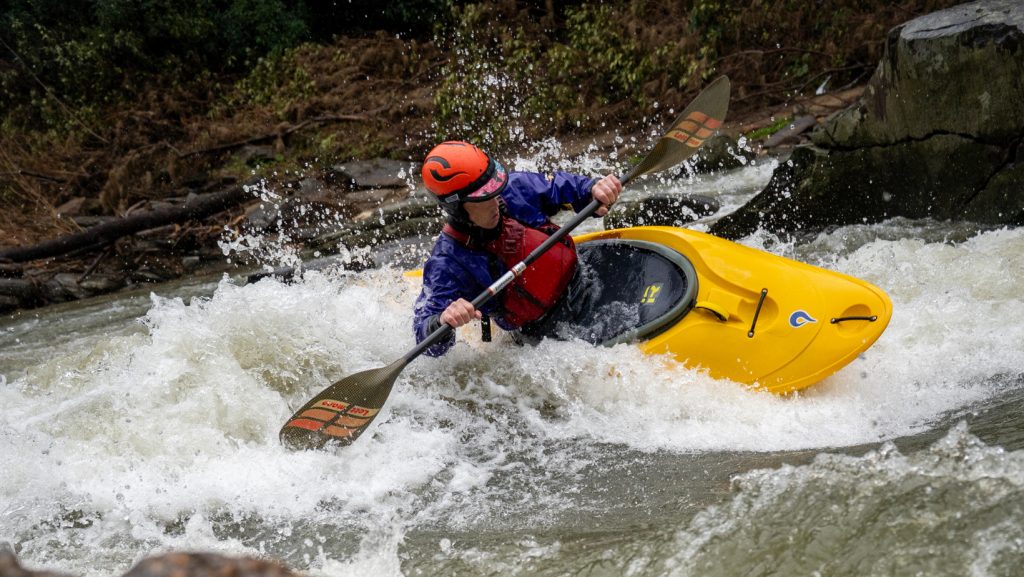
Photo Credit: Stephen McGrady
“They say it’s going to be a big one,” my friend said as we looked across the French Broad at the Ledges Park after an all-day session.
“I doubt it. They always say that,” I replied, skeptical.
The next day Hurricane Helene blew trees across my yard like leaves. Water poured through the walls of my house like it was an oversized colander. The storm flattened and flooded Western North Carolina.
The first few weeks after Helene were a battle. My time was consumed by survival. With food, water and energy at a premium, outdoor recreation seemed like a silly joke—a child’s game torn away by the storm.
Local, state and federal authorities flooded our city almost as quickly as Helene had. Linemen from Ohio, Pennsylvania, and Tennessee inundated neighborhoods, working endless hours to reestablish power, water and internet grids. Within a month, life reverted to semi-normal, and I no longer had to worry about necessities.
I drifted back to the water, as I always do. With local kayaking options limited, I extended my tolerance for driving and day tripped to the Chattooga and Russell Fork. I checked out local runs, too. Thousands of PVC pipes littered the French Broad like pick-up sticks. The Nolichucky and Pigeon were active construction zones. The Green—the defining river of my life—was unrecognizable.
I will always be an avid paddler, but age dulls the edge. I no longer obsess over the sport as I did in my younger years. Still, the loss of my standby rivers was a blow. I’ll spend more time on the bike, I thought. Local mountain bike crews buzzed through Pisgah National Forest like a pack of angry beavers, transforming the trails into serviceable condition within a few weeks of the storm. I chased the feeling of boofing Gorilla or carving a glassy wave on my bike to no avail. There is no replacement for the flow I find on the water.
One day I received a text from a friend. “Have you paddled Hepco yet? It’s good.”
“What the hell is Hepco?”
“It’s a section of the Pigeon above the lake. Check it out.”
The next day I dropped my son off at school in West Asheville and drove straight to the river. The drive took 40 minutes. Wow, it’s close. If it really is good, I’ll be here all the time.
A few hours later I floated out of the gorge with new hope for Asheville kayaking. The Hepco section—long neglected by local paddlers due to toxic water from a recently shuttered papermill—now runs clear. The flood scoured decades-old black sludge off the rocks and improved the quality of the whitewater. The eight-mile section features four miles of Class III and IV whitewater reminiscent of the run-out rapids on the Pigeon Dries, but with West Virginia style bread loaf rocks, deep eddy lines and surfable wave trains. Two standout waves provide long soul surfing sessions, and two rapids are bigger than anything on the Pigeon Gorge.
Bruce Springsteen said, “Everything dies baby, that’s a fact. But maybe everything that dies someday comes back.” He went to Atlantic City seeking luck and redemption. When the winter rain falls, I’ll be reborn at Hepco.
Thank you to Adam Herzog for contributing “Hurricane Helene’s Silver Lining” to the ACA Story Project. Adam’s story is a powerful reminder of the beauty and resilience that can emerge in the wake of disaster.
About the Author
Adam Herzog joined the ACA in 2023 and brings over two decades of experience in emergency care to his work on the river. After retiring from a 22-year career in EMS and emergency and trauma nursing, Adam shifted his focus to teaching whitewater kayaking and wilderness medicine with the Nolichucky Outdoor Learning Institute. A seasoned paddler and competitor, Adam has raced the Green Narrows 15 times, consistently posting sub-five-minute runs. He lives in Asheville, North Carolina, where he continues to share his passion for paddling, safety, and lifelong learning.

